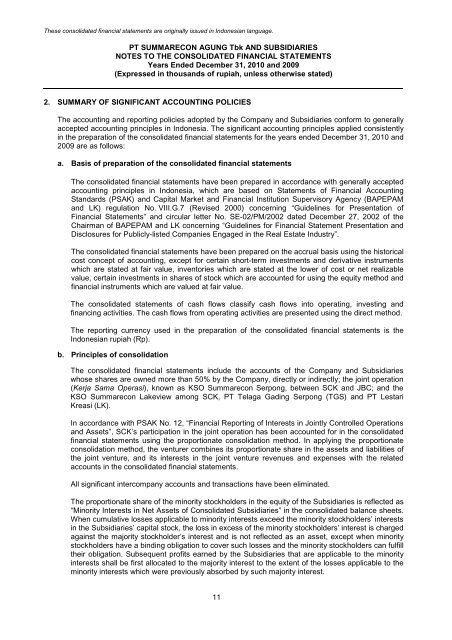PT Summarecon Agung Tbk | Laporan Tahunan 2010 Annual Report
PT Summarecon Agung Tbk | Laporan Tahunan 2010 Annual Report
PT Summarecon Agung Tbk | Laporan Tahunan 2010 Annual Report
Create successful ePaper yourself
Turn your PDF publications into a flip-book with our unique Google optimized e-Paper software.
These consolidated financial statements are originally issued in Indonesian language.<br />
<strong>PT</strong> SUMMARECON AGUNG <strong>Tbk</strong> AND SUBSIDIARIES<br />
NOTES TO THE CONSOLIDATED FINANCIAL STATEMENTS<br />
Years Ended December 31, <strong>2010</strong> and 2009<br />
(Expressed in thousands of rupiah, unless otherwise stated)<br />
2. SUMMARY OF SIGNIFICANT ACCOUNTING POLICIES<br />
The accounting and reporting policies adopted by the Company and Subsidiaries conform to generally<br />
accepted accounting principles in Indonesia. The significant accounting principles applied consistently<br />
in the preparation of the consolidated financial statements for the years ended December 31, <strong>2010</strong> and<br />
2009 are as follows:<br />
a. Basis of preparation of the consolidated financial statements<br />
The consolidated financial statements have been prepared in accordance with generally accepted<br />
accounting principles in Indonesia, which are based on Statements of Financial Accounting<br />
Standards (PSAK) and Capital Market and Financial Institution Supervisory Agency (BAPEPAM<br />
and LK) regulation No. VIII.G.7 (Revised 2000) concerning “Guidelines for Presentation of<br />
Financial Statements” and circular letter No. SE-02/PM/2002 dated December 27, 2002 of the<br />
Chairman of BAPEPAM and LK concerning “Guidelines for Financial Statement Presentation and<br />
Disclosures for Publicly-listed Companies Engaged in the Real Estate Industry”.<br />
The consolidated financial statements have been prepared on the accrual basis using the historical<br />
cost concept of accounting, except for certain short-term investments and derivative instruments<br />
which are stated at fair value, inventories which are stated at the lower of cost or net realizable<br />
value, certain investments in shares of stock which are accounted for using the equity method and<br />
financial instruments which are valued at fair value.<br />
The consolidated statements of cash flows classify cash flows into operating, investing and<br />
financing activities. The cash flows from operating activities are presented using the direct method.<br />
The reporting currency used in the preparation of the consolidated financial statements is the<br />
Indonesian rupiah (Rp).<br />
b. Principles of consolidation<br />
The consolidated financial statements include the accounts of the Company and Subsidiaries<br />
whose shares are owned more than 50% by the Company, directly or indirectly; the joint operation<br />
(Kerja Sama Operasi), known as KSO <strong>Summarecon</strong> Serpong, between SCK and JBC; and the<br />
KSO <strong>Summarecon</strong> Lakeview among SCK, <strong>PT</strong> Telaga Gading Serpong (TGS) and <strong>PT</strong> Lestari<br />
Kreasi (LK).<br />
In accordance with PSAK No. 12, “Financial <strong>Report</strong>ing of Interests in Jointly Controlled Operations<br />
and Assets”, SCK’s participation in the joint operation has been accounted for in the consolidated<br />
financial statements using the proportionate consolidation method. In applying the proportionate<br />
consolidation method, the venturer combines its proportionate share in the assets and liabilities of<br />
the joint venture, and its interests in the joint venture revenues and expenses with the related<br />
accounts in the consolidated financial statements.<br />
All significant intercompany accounts and transactions have been eliminated.<br />
The proportionate share of the minority stockholders in the equity of the Subsidiaries is reflected as<br />
“Minority Interests in Net Assets of Consolidated Subsidiaries” in the consolidated balance sheets.<br />
When cumulative losses applicable to minority interests exceed the minority stockholders’ interests<br />
in the Subsidiaries’ capital stock, the loss in excess of the minority stockholders’ interest is charged<br />
against the majority stockholder’s interest and is not reflected as an asset, except when minority<br />
stockholders have a binding obligation to cover such losses and the minority stockholders can fulfill<br />
their obligation. Subsequent profits earned by the Subsidiaries that are applicable to the minority<br />
interests shall be first allocated to the majority interest to the extent of the losses applicable to the<br />
minority interests which were previously absorbed by such majority interest.<br />
11


